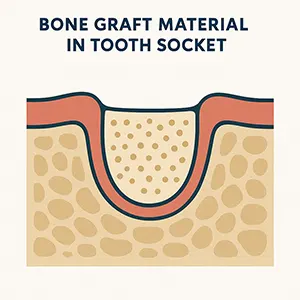Bone Graphting

When a tooth is removed, the bone that supported it naturally begins to shrink or resorb over time. This can lead to loss of bone height and width in your jaw. If this process continues, it can be difficult to place a dental implant into the site. To prevent this, a bone graft is placed immediately after the extraction.
A bone graft involves gently placing natural or synthetic bone material into the empty tooth socket. This material acts as a framework that encourages your body to grow new bone in the area, allowing the best chance for an implant to be placed in the future.
Why is Bone Grafting Done After Extraction?
✅ Preserves the jawbone – Prevents the natural shrinkage that follows tooth loss.
✅ Prepares for dental implants – Creates a strong, stable foundation to hold an implant securely in the future.
✅ Maintains facial shape – Preserves the natural contours of your smile and prevents a “sunken” look.
✅ Protects nearby teeth – Helps keep the surrounding teeth and gums stable.
What to Expect
-
- The grafting material is placed at the time of extraction.
- Over the next several months, your body naturally replaces it with new bone.
- Once healed, the area will be strong enough for a dental implant or other restoration.
👉 In short: bone grafting after an extraction protects your jawbone and keeps future treatment options open, especially if you’re considering a dental implant.
